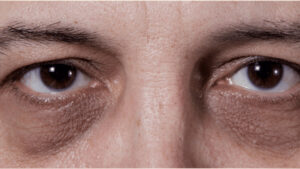What are dark circle under the eye?
- When the skin under both of your eyes appears darker than usual, you have dark circles under your eyes.
- It differs from bruising around one eye following an accident or redness and swelling brought on by an infection in one eye.
- Typically, dark circles under the eyes are not a symptom of a health issue.
- Depending on the color of the skin, dark circles beneath the eyes can appear purple, blue, dark brown, or even black.
- Even though these circles are rarely a cause for concern, some people might choose to hide them for aesthetic reasons.

Causes / Etiology of dark circles under eyes:
Many people believe that weariness and sleep deprivation are the causes of dark circles. There are other causes of dark circle under eye than this one, such as allergies or the ageing process. Dark circles beneath the eyes may occasionally signal a need for lifestyle adjustments, such as better eating or sleeping habits. The skin around the eyes may thinning or constricted blood vessels causing hyperpigmentation may make the region under the eyes appear darker.
All of the following factors can contribute to dark circles under the eyes:
- Insomnia or poor sleeping habits
- allergies, such as hay fever
- hyperpigmentation, which occurs when the body produces more melanin; decreased levels of fatty tissue around the eyes
- thin skin around the eyes
- anemia from iron deficiency
- excessive sun exposure
- rubbing your eyes a lot
- ageing
- smoking
- inherited factor
- thyroid disorders
- dehydration
- dermatitis
- Certain drugs also leads to dark circle around eyes.
Actually, there are a variety of causes for dark circles. Lack of sleep isn’t the only cause.
Below we discuss some factors in detail,
Certain drugs:
- Certain drugs also cause dark circle under the eyes, for example, bimatoprost that is used for glaucoma.
- When people stop using certain medications, such as bimatoprost for glaucoma, their dark circles under the eyes will go away.
Exhaustion:
- There are numerous causes of dark circles, while fatigue may seem to be the most common.
- Dark circles under the eyes might develop as a result of acute exhaustion or simply staying up later than usual.
Oversleeping:
- Your skin may become dull and darker as a result of oversleeping. Your skin’s dark tissues and blood vessels may start to protrude.
Sleep deprivation (Lack of Sleep):
- Sleep deprivation can also result in fluid accumulating under your eyes, giving them a puffy appearance. The shadows generated by swollen eyelids may be the cause of the dark circles you experience.
Age:
- Another typical cause of dark circles under your eyes is natural ageing.
- Your skin becomes thinner as you become aged.
- It’s possible that the collagen and lipids that keep your skin healthy will decline with age and the area behind your eyes darkens as a result of the exposed dark blood veins beneath your skin.
Eyestrain:
- Your eyes may become tired if you continuously stare at a computer or television screen.
- Your eye area’s blood vessels may swell as a result of this strain.
- The skin around your eyes may subsequently darken as a result.
Allergies:
- Dark circles may result from allergic responses or dry eyes.
- Histamines are released by your body during an allergic reaction to ward off the intruder.
- This results in a number of symptoms, such as itching, redness, and puffy eyes.
- Additionally, histamines cause your blood vessels to enlarge and become more noticeable under your skin.
- Your desire to rub and scratch the irritated area around your eyes may grow if you have allergies.
- These behaviors may exacerbate your symptoms by resulting in edema, blood vessel damage, and inflammation.
- This may cause deep shadows under your eyes.
Dehydration:
- Your under-eye circles are frequently caused by dehydration.
- When your body is dehydrated, your eyes appear sunken and the skin around your eyes starts to look lifeless.
- This is because the eyeballs are so close to the underlying bone.
Sun overexposure:
- A surplus of melanin, the pigment that provides your skin color, may be produced by your body as a result of exposure to the sun.
- The pigmentation of the skin under your eyes, in particular, can darken with too much sun exposure.
Genetics:
- Family history might also have an impact on the appearance of dark circles beneath your eyes.
- It might be an inherited quality that manifests early in life.
- The dark circles could become lighter or darker over time.
- Dark circles under your eyes might also be a sign of predisposition to other medical issues, like thyroid disease.
Anemia:
When your red blood cell counts are below normal, you have anemia. It causes following side effects:
- dizziness
- weakness
- lightheadedness
- shortness of breath
- fatigue.
If you have anemia, you could also notice that your skin is paler than usual and that you have dark circles under your eyes. Consult your doctor about getting blood testing done to assess your iron levels.
Treatments for anemia include:
- Dietary adjustment
- Iron supplements
- Iron infusions according to your need.
Risk factors for dark circles under the eyes:
Given categories have more prone to develop dark circles around the eye:
- Old aged people
- those who are genetically predisposed to the illness
- those who have darker skin tones since they are more likely to develop hyperpigmentation around their eyes
Age:
- As we become older, our bodies lose fatty tissue, which causes the skin around our eyes to thin.
- Older folks may notice that these alterations give dark circles a more defined appearance.
- The depression under the eyes, known as a tear trough, is linked to ageing and can result in dark rings.
Ethnicity other than white:
- People with darker skin tones are more likely to have dark circles, and people of color are more likely to experience them than white people.
- It is believed that variations in pigmentation are the cause of this risk factor.
Genetics:
- Dark circles may run in families. According to research, some members of a person’s family may also have dark circles beneath their eyes.
Home remedies for dark circle:
- The underlying cause of dark undereye circles will determine the best course of treatment.
- Simple home remedies may help people to lessen the look of dark circles beneath their eyes.
- Even though some of these cures lack scientific basis, many of them are affordable and have no negative side effects, so they might be worth a go.
- Following are some home remedies for black circles under eye:
Get more sleep:
- Sleeping more may also assist in minimizing the look of dark circles. Your skin may look paler as a result of lack of sleep, highlighting the dark circles.
Cucumber:
- Slices of cucumber applied to the eyes may relieve soreness and constrictiveness.
- Cucumbers’ high water and vitamin C content may support skin hydration and nourishment.
- Silica, which is necessary for healthy tissue, is also present in cucumbers.

Use an ice compress:
- A cold compress may lessen swelling and constrict dilated blood vessels to lessen the appearance of puffiness and dark circles.
- Apply some ice to your eyes by wrapping it in a fresh washcloth.
- For the same result, you can alternatively wet a washcloth in cold water and apply it for 20 minutes to the skin around your eyes.
Raise your head:
- While lack of sleep may contribute to the development of those dark bags under your eyes, other times it’s due to your sleeping habits.
- Consider using a few pillows to raise your head.
- This could stop moisture from collecting under your eyes, which would otherwise make them appear bloated and puffy.
Keep yourself hydrated:
- Try your best to consume extra water. Juices, milk, tea, and other fluids can all help you stay hydrated.
- Consuming fruits and vegetables also helps you drink more water overall.
Soaked with tea bags:
- Tea includes antioxidants and caffeine that can help thin the blood, constrict blood vessels, and lessen fluid retention beneath the skin.
- Two black or green tea bags should be steeped in hot water for five minutes before being chilled for fifteen to twenty minutes in the refrigerator.
- Apply the tea bags to your closed eyes after they are cold for 10 to 20 minutes, then take them off and rinse your eyes with cool water. People can make use of herbal, green, or black tea bags.

Use of almond oil with vitamin E:
- According to Rashidi, applying almond oil and vitamin E oil combined to the under-eye area will help to reduce puffiness and remove dark circles because these two oils have anti-inflammatory and antioxidant characteristics that work well together.
- Almond oil is rich in fatty acids that will help hydrate the skin and lessen the appearance of dark circles.
- Additionally, almond oil is UV protective, which is crucial for protecting the delicate skin under your eyes.
- Almond oil also contains retinol and vitamin K, which together with vitamin E, can help keep the delicate skin under your eyes smooth without it irritating.
Facials:
- Dark circles around the eyes may form as a result of poor circulation. A facial might assist to improve circulation by gently massaging the area around the eyes.
Skincare products containing antioxidants:
- Antioxidant-rich face creams and under-eye treatments may help to lessen the visibility of dark circles.
- Antioxidants like vitamin E and C may be used to relieve dark circles.
Use makeup to mask:
- Concealers can cover dark circles to make them disappear and blend in with your natural skin tone.
- There is a potential of irritation or an allergic reaction, just like with any topical medication or cosmetic.
- Stop using it and think about consulting a doctor if you experience any negative effects.
Medical treatments:
A person might consult their doctor or dermatologist for advice on medical treatment if at-home methods do not successfully eliminate dark circles around the eyes.
Options for medical treatment include:
Topical creams/ointments:
- Creams that bleach the skin can assist to lessen hyperpigmentation. These could consist of: hydroquinone, tretinoin, or a mixture of the two.
- For hydroquinone to work, people may need to utilize it for at least three months.
Kojic acid:
- According to Anecdotal evidence, Kojic acid is useful for treating dark circles.
- Two types of fungi produce the natural substance Kojic acid.
- But it’s crucial to be aware that Kojic acid can also cause contact dermatitis and skin reddening as a side effect.
Azelaic acid:
- It is safe to take azelaic acid for extended periods of time to treat hyperpigmentation under the eyes.
Topical vitamin C:
- In a trial, 10 percent vitamin C lotion was used to alleviate dark circles for a period of six months.
- The lotion proved successful in eradicating under-eye shadows.
Chemical peels:
- Hyperpigmentation under the eyes can be lightened using chemical peels that use alpha hydroxy acids like glycolic acid.
- For better results, people may also combine chemical peels with topically applied lotions.
Lasers:
- Dark circles may be effectively treated using laser therapy.
- Scarring risk and other potential side effects may be reduced by less intrusive laser techniques such pulsed dye or diode lasers.
Fillers:
- Fillers can be a possible solution if skin thinning or a lack of fatty tissue is the cause of your under-eye circles.
- Platelet rich plasma (PRP) injections or hyaluronic acid gel can be given as under-eye injections to patients.
Surgery:
- Dark circles caused by fat deposits or extra skin around the eye area can be eliminated by a procedure known as blepharoplasty.
- People should always talk about potential side effects because the area under the eye is quite delicate.
- They must also make sure that any medical operations for this region are exclusively performed by certified dermatologists.
Prevention:
By changing their lifestyles, people can help prevent the development of dark circles.
Getting enough sleep and reduce stress:
- The presence of dark circles was observed to be exacerbated by stress, but relaxation and healthy lifestyle choices reduced discoloration.
Protecting the eyes from the sun:
- Dark circles can be avoided or diminished by using sunscreen and UV-protective eyewear that cover the area around the eyes.
Quit smoking and reduce alcohol consumption:
- Smoking and drinking too much alcohol can hasten the ageing process of the body and may make dark circles more likely.
- So by quit smoking and stop alcohol consumption we can avoid the dark circle around the eye.
When to see a healthcare provider:
- You should consult your doctor if swelling and discoloration only affect one eye, especially if they seem to worsen over time.
What your doctor might suggest for dark circles:
- Depending on how they identify the origin of your under-eye circles, your doctor may suggest a medicinal solution.
- The following could be part of that advice:
Skin-lightening cream:
- A dermatologist may recommend a skin-lightening lotion with azelaic acid, kojic acid, glycolic acid, or hydroquinone to reduce under-eye hyperpigmentation.
- Some of these creams are available over-the-counter formulations with lesser concentrations of the active ingredient.
Laser therapy:
- Laser treatments evaporate harmed cells using heat energy.
- Laser therapy may cause the creation of new collagen in addition to whitening darker skin tones.
Chemical peels:
- To reduce dark pigmentation under the eyes, a dermatologist could advise a gentle chemical peel. These frequently contain hydroquinone, retinoic acid, or glycolic acid.
- A Jessner peel, which combines salicylic acid, lactic acid, and resorcinol, may also be recommended by your dermatologist.
Blepharoplasty:
- A plastic surgeon, oculoplastic surgeon, or dermatologic surgeon can remove fat surgically during a lower lid blepharoplasty.
- The technique might lessen the shadow that your eyelid creates, which can make dark circles appear less prominent.
Fillers:
- An ophthalmologist, dermatologist, plastic surgeon, or other medical professional with the appropriate training can inject a hyaluronic acid-based dermal filler into the tissue under the eye, such as Restylane or Juvederm.
- Dark circles beneath the eyes can be caused by volume loss, which fillers help to prevent.

